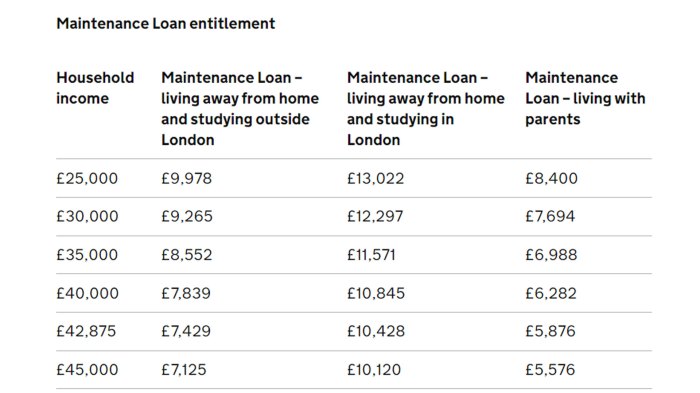
Navigating the world of student loans can feel overwhelming, especially when faced with a maze of deadlines and application processes. Understanding the nuances of student loan application dates is crucial for securing the funding you need for your education. This guide will demystify the complexities, providing a clear path to successfully applying for student loans and ensuring you meet all necessary deadlines.
From understanding the variations in deadlines across different lenders and loan types to mastering the application process itself, we’ll cover everything you need to know. We’ll explore the potential consequences of late applications and offer practical strategies to ensure timely submission. Ultimately, our goal is to empower you with the knowledge and tools to confidently navigate the student loan application process.
The Application Process Timeline

Applying for student loans can seem daunting, but understanding the process and timeline can significantly reduce stress. This section provides a step-by-step guide, outlining the typical application procedure and the necessary documentation at each stage. We will also illustrate the process with a flowchart and provide estimated processing times.
The application process generally involves several key stages, each with its own set of requirements and timelines. Successful navigation requires careful planning and attention to detail. Remember that specific requirements may vary depending on the lender and your individual circumstances.
Application Submission
This initial step involves completing the loan application form provided by your chosen lender. Accuracy is paramount; errors can lead to delays. Be prepared to provide personal information, details about your chosen course of study, and estimated educational costs.
- Required Documentation: Completed application form, proof of identity (e.g., passport, driver’s license), social security number, and details of your chosen educational institution and program.
- Average Processing Time: 1-3 business days for initial application review.
Verification of Information
Once your application is submitted, the lender will verify the information you provided. This step is crucial to ensure the accuracy of your application and to assess your eligibility for the loan. Be prepared to respond promptly to any requests for additional documentation.
- Required Documentation: May include transcripts, proof of enrollment, tax returns (or proof of income for co-signers), and bank statements.
- Average Processing Time: 5-10 business days, depending on the complexity of verification and the responsiveness of the applicant.
Credit Check (if applicable)
For some loan types, a credit check is conducted to assess your creditworthiness. This involves a review of your credit history to determine your repayment capability. A strong credit history can expedite the process.
- Required Documentation: No additional documentation is usually required for this step; the lender will access your credit report directly.
- Average Processing Time: 1-2 business days. Delays may occur if there are discrepancies in your credit report.
Loan Approval/Denial
After the verification and credit check (if applicable), the lender will review your application and make a decision. Approval leads to the disbursement of funds, while denial usually includes an explanation of the reasons for rejection.
- Required Documentation: No additional documentation is typically required at this stage.
- Average Processing Time: 1-5 business days after the completion of verification and credit checks. The timeline can be significantly longer if additional information is required.
Loan Disbursement
If your application is approved, the funds will be disbursed according to the lender’s schedule and the institution’s requirements. This may involve multiple payments spread throughout the academic year.
- Required Documentation: You may need to provide bank account details for direct deposit of the loan funds.
- Average Processing Time: 1-2 weeks after loan approval. The timing can depend on the chosen disbursement method and the institution’s processing times.
Flowchart Illustrating the Key Steps
The following describes a flowchart illustrating the student loan application process. Imagine a diagram with boxes and arrows. The first box would be “Application Submission,” leading to a diamond-shaped decision point: “Information Complete?” A “Yes” branch leads to “Verification of Information,” and a “No” branch loops back to “Application Submission.” “Verification of Information” leads to another decision point: “Credit Check Required?” A “Yes” branch goes to “Credit Check,” and a “No” branch leads to “Loan Approval/Denial.” “Credit Check” leads to “Loan Approval/Denial.” Finally, “Loan Approval/Denial” has a “Yes” branch leading to “Loan Disbursement” and a “No” branch to “Application Denial.”
Impact of Late Applications
Submitting your student loan application after the deadline can have significant consequences, potentially impacting your ability to fund your education and significantly delaying your start date. The severity of these consequences varies depending on the lender and the specific circumstances. Understanding these potential repercussions is crucial for timely application submission.
Late applications often result in a cascade of negative effects, ranging from simple delays to complete rejection of your application. The financial implications can be substantial, potentially leaving students with insufficient funds to cover tuition fees, accommodation, books, and other essential living expenses.
Consequences of Late Student Loan Applications
Delays and rejections are the most common outcomes of late applications. Some lenders may simply delay the disbursement of funds, pushing back the start of your academic year. Others may reject the application outright, leaving you without the necessary financial support for your studies. In certain cases, a late application might lead to a reduced loan amount or less favorable interest rates. For example, a student applying a month late for a loan might find their application processed but with a smaller loan amount than originally requested, insufficient to cover their total costs. This could force them to take out additional loans with higher interest rates or seek alternative funding solutions, such as part-time jobs, which may impact their academic performance.
Scenarios for Late Applications
Several scenarios can unfold when a student loan application is submitted late. Rejection is a possibility, particularly if the lender has already allocated its funds or has a strict “no exceptions” policy for late applications. Delayed disbursement is another common outcome; the loan might be approved but the funds might not reach the student’s account until after the semester begins. This could result in late tuition fees, impacting the student’s enrollment status. In some cases, the lender might offer an alternative loan option, such as a smaller loan amount or a loan with less favorable terms. This is not always guaranteed and depends entirely on the lender’s policies. Finally, students may be forced to explore alternative funding methods like personal loans or family contributions to make up for the shortfall. For instance, a student whose loan application is delayed might need to rely on credit cards to pay for immediate expenses, incurring significant debt with high interest rates.
Financial Impact on Students
The financial repercussions of a late application can be substantial. Delayed disbursement of funds could result in late fees for tuition, impacting enrollment and potentially even leading to suspension. Students might be forced to withdraw from courses, resulting in academic setbacks and potentially higher overall costs in the long run. Inability to cover living expenses could mean foregoing necessities such as food and housing, impacting the student’s health and well-being. Furthermore, resorting to alternative, high-interest loans to bridge the funding gap could result in long-term financial difficulties after graduation. For example, a student who had to use a high-interest credit card to cover tuition and living expenses due to a delayed loan disbursement might face years of debt repayment after graduation, impacting their ability to save for a down payment on a house or other major life goals.
Potential Consequences of Late Applications: Severity Summary
| Severity | Consequence | Example | Impact |
|---|---|---|---|
| Minor | Slight delay in disbursement | Loan approved but funds arrive a week late. | Potential for minor late fees. |
| Moderate | Reduced loan amount | Application approved, but for a smaller amount than requested. | Need to find alternative funding sources. |
| Severe | Application rejection | Application denied due to late submission. | Inability to attend classes; need to find completely alternative funding. |
| Critical | Significant financial hardship | Late application leads to reliance on high-interest credit cards to cover expenses. | Long-term debt and potential negative impact on credit score. |
Resources and Support for Applicants
Navigating the student loan application process can be challenging, but numerous resources and support systems are available to help students successfully complete their applications and secure the funding they need for their education. Understanding these resources and knowing how to access them is crucial for a smooth and stress-free application experience.
Applying for student loans requires careful planning and attention to detail. Missing deadlines or submitting incomplete applications can significantly impact your chances of receiving funding. Fortunately, various support systems are in place to assist students throughout the process, from providing information about deadlines to offering guidance on financial aid options. Effective utilization of these resources can greatly enhance your chances of a successful application.
Reliable Resources for Information on Student Loan Applications
Finding accurate and up-to-date information about student loan application deadlines and procedures is essential. Several reputable sources provide comprehensive guidance, ensuring applicants have access to the necessary details to complete their applications correctly and on time. These resources often include detailed instructions, FAQs, and contact information for further assistance.
- The Federal Student Aid website (studentaid.gov): This is the primary source for information on federal student loans in the United States. It offers detailed information on eligibility, application procedures, and repayment plans.
- Your college or university’s financial aid office: Your institution’s financial aid office provides personalized support and guidance specific to your school’s policies and deadlines. They can answer your questions and help you navigate the application process.
- State-specific higher education agencies: Many states have agencies that administer state-based student aid programs. These agencies can provide information on state-specific grants, scholarships, and loan programs.
Support for Students Struggling to Meet Deadlines
Students facing challenges in meeting application deadlines can access various support services. These services provide assistance and guidance to help students overcome obstacles and successfully submit their applications. Proactive engagement with these support systems is key to navigating potential difficulties.
- Financial aid advisors: Colleges and universities employ financial aid advisors who provide personalized counseling and guidance to students. They can help students understand their financial aid options, complete the necessary forms, and meet deadlines.
- Student loan counselors: Independent student loan counselors can provide objective advice and support, helping students compare loan options and understand the implications of different repayment plans. They can also help students navigate the complexities of the application process.
- Academic advisors: While not solely focused on financial aid, academic advisors can provide support and guidance to students facing academic or personal challenges that might impact their ability to meet application deadlines.
Utilizing Online Tools and Resources for Application Management
Effective use of online tools and resources can significantly streamline the student loan application process. These tools allow students to track deadlines, manage documents, and communicate with financial aid offices efficiently. Proactive use of these resources is essential for a smooth application experience.
- Online portals: Many institutions and government agencies provide online portals where students can track their application status, submit documents, and communicate with financial aid officers. These portals offer a centralized location for managing the entire application process.
- Digital document management: Organizing and storing all application documents digitally is crucial for efficient access and submission. Using cloud-based storage or dedicated folders on your computer can help prevent lost or misplaced documents.
- Calendar reminders: Setting calendar reminders for important deadlines, such as application submission dates and required documentation submission dates, ensures that students remain on track throughout the process.
Helpful Websites and Organizations
Several websites and organizations provide comprehensive assistance with student loan applications. These resources offer valuable information, tools, and support to help students navigate the process effectively.
- Federal Student Aid (studentaid.gov): The official website for federal student aid in the United States.
- National Association of Student Financial Aid Administrators (NASFAA): A professional organization that provides resources and information on student financial aid.
- The Institute for College Access & Success (TICAS): A non-profit organization that advocates for college affordability and student success.
Visual Representation of Deadlines

Creating a clear and easily understandable visual aid for student loan application deadlines is crucial for applicant success. A well-designed calendar or infographic can significantly reduce confusion and missed deadlines, ultimately improving the application process. This section details the design specifications for such a visual.
A visually appealing and informative calendar or infographic will be created to display key application deadlines. The design prioritizes clarity and accessibility, ensuring that all applicants, regardless of their technical skills, can easily interpret the information presented.
Color Scheme and Font Choices
The color scheme will employ a visually calming and organized palette. For instance, a base of soft blues and greens can be used to create a sense of trustworthiness and reliability, often associated with financial institutions. Accent colors, such as a vibrant orange or a deep teal, will highlight important dates, such as priority deadlines or final submission dates. The font will be a clear and easily readable sans-serif typeface, such as Arial or Calibri, in a size large enough to be easily legible for all users, even those with visual impairments. Different font weights (bold, regular, italic) will be used to distinguish between different levels of information, such as titles, deadlines, and text.
Calendar or Infographic Layout
The visual will utilize a month-by-month calendar layout, clearly marking key deadlines for each loan type (e.g., federal Stafford loans, private loans from various lenders). Each loan type will be color-coded for easy identification. The calendar will feature clear visual indicators, such as differently shaped icons or color-coded boxes, to represent different deadlines (e.g., application submission, documentation verification, disbursement dates). This will allow applicants to easily track their progress and anticipate upcoming deadlines. For example, a green checkmark might indicate a completed task, while a red exclamation point might highlight an upcoming deadline. A legend explaining the meaning of each icon and color code will be included. The infographic could also incorporate a timeline to visualize the application process from start to finish. This timeline will clearly illustrate the sequence of events and the duration of each stage. For example, it could show the time it takes for application processing and loan disbursement.
Information Hierarchy and Accessibility
The visual will prioritize clear information hierarchy. Key deadlines will be prominently displayed using larger font sizes and bold text. Secondary information, such as contact details or links to relevant resources, will be presented in a less prominent manner. To ensure accessibility, the visual will adhere to WCAG (Web Content Accessibility Guidelines) standards. This includes sufficient color contrast between text and background, appropriate font sizes, and alternative text descriptions for any visual elements. The visual will also be available in multiple formats (e.g., PDF, image) to cater to different user needs. Furthermore, the visual will be designed to be easily printable for those who prefer a hard copy.
Ultimate Conclusion

Securing student loans requires careful planning and attention to detail. By understanding the intricacies of application deadlines, the application process itself, and the potential repercussions of late submissions, you can significantly increase your chances of a successful outcome. Remember to utilize the resources and support available to you, and don’t hesitate to seek assistance when needed. Proactive planning and informed decision-making are key to a smooth and successful student loan application experience.
Question Bank
What happens if I miss the priority deadline for a student loan?
Missing the priority deadline may reduce your chances of securing funding, potentially leading to a longer processing time or even loan unavailability depending on the lender and funding availability.
Can I apply for student loans after the academic year starts?
It’s possible, but you may face delays in receiving funds, potentially impacting your ability to cover immediate tuition or living expenses. Contact the lender directly to inquire about late application policies.
Where can I find a list of all federal student loan deadlines?
The Federal Student Aid website (studentaid.gov) is the best resource for information on federal student loan deadlines and application processes.
What types of documentation are typically required for a student loan application?
Common requirements include proof of enrollment, FAFSA completion (for federal loans), tax returns, bank statements, and possibly co-signer information.
